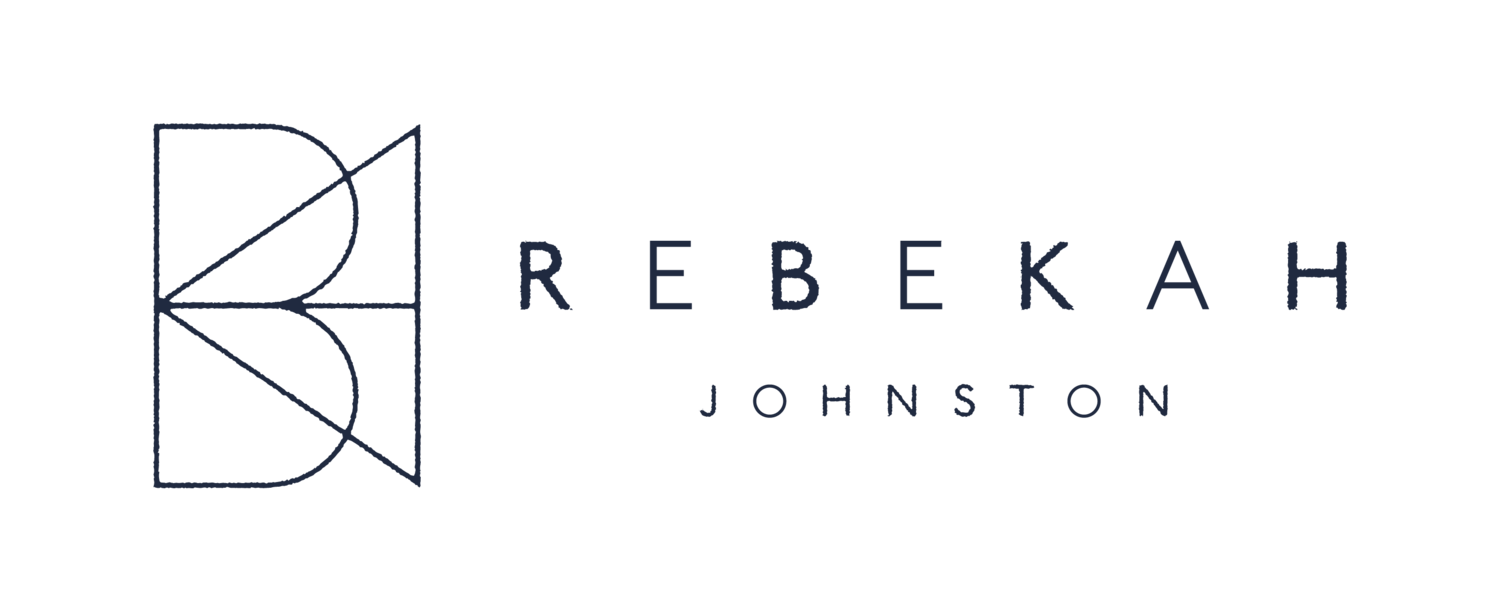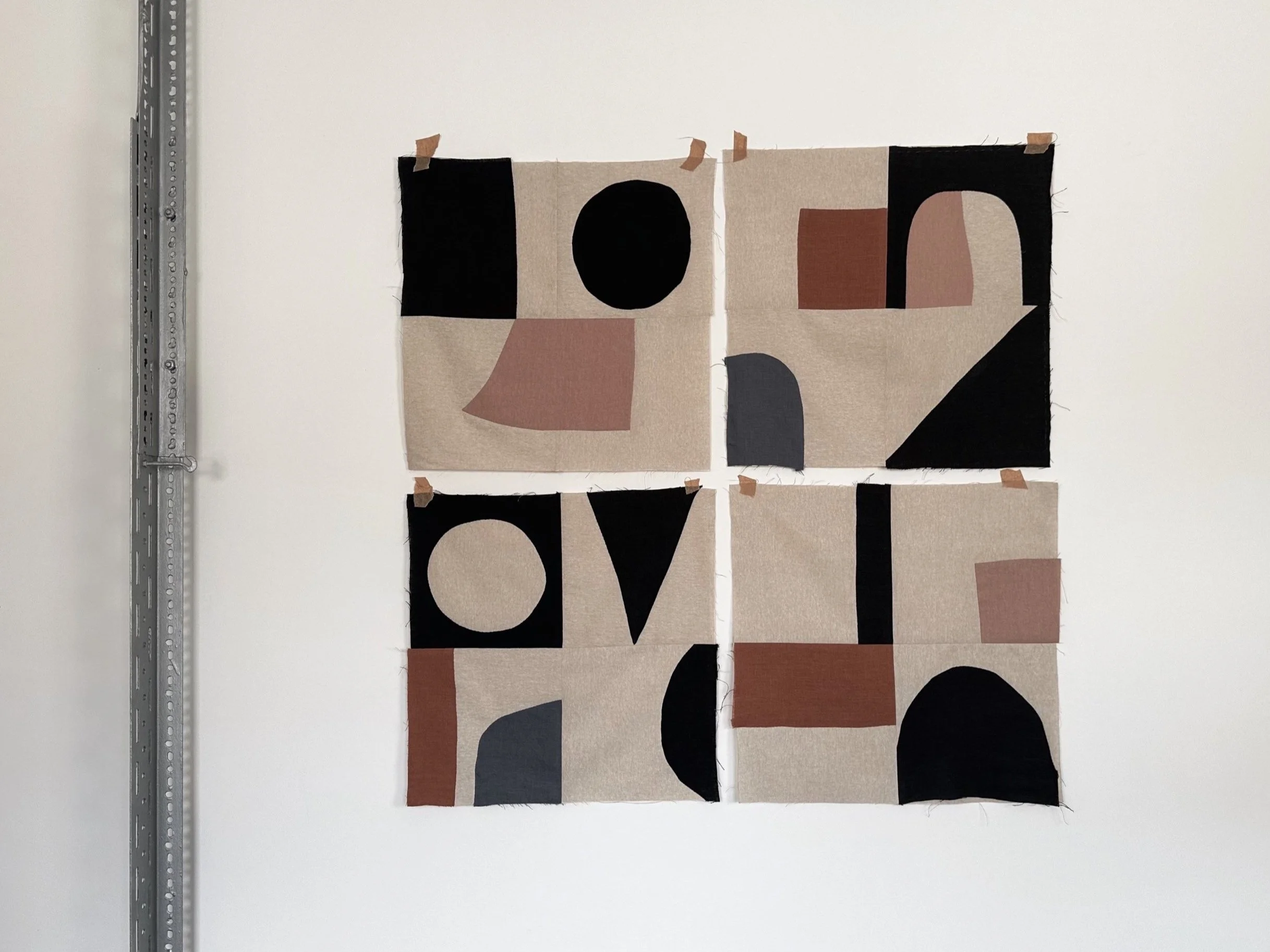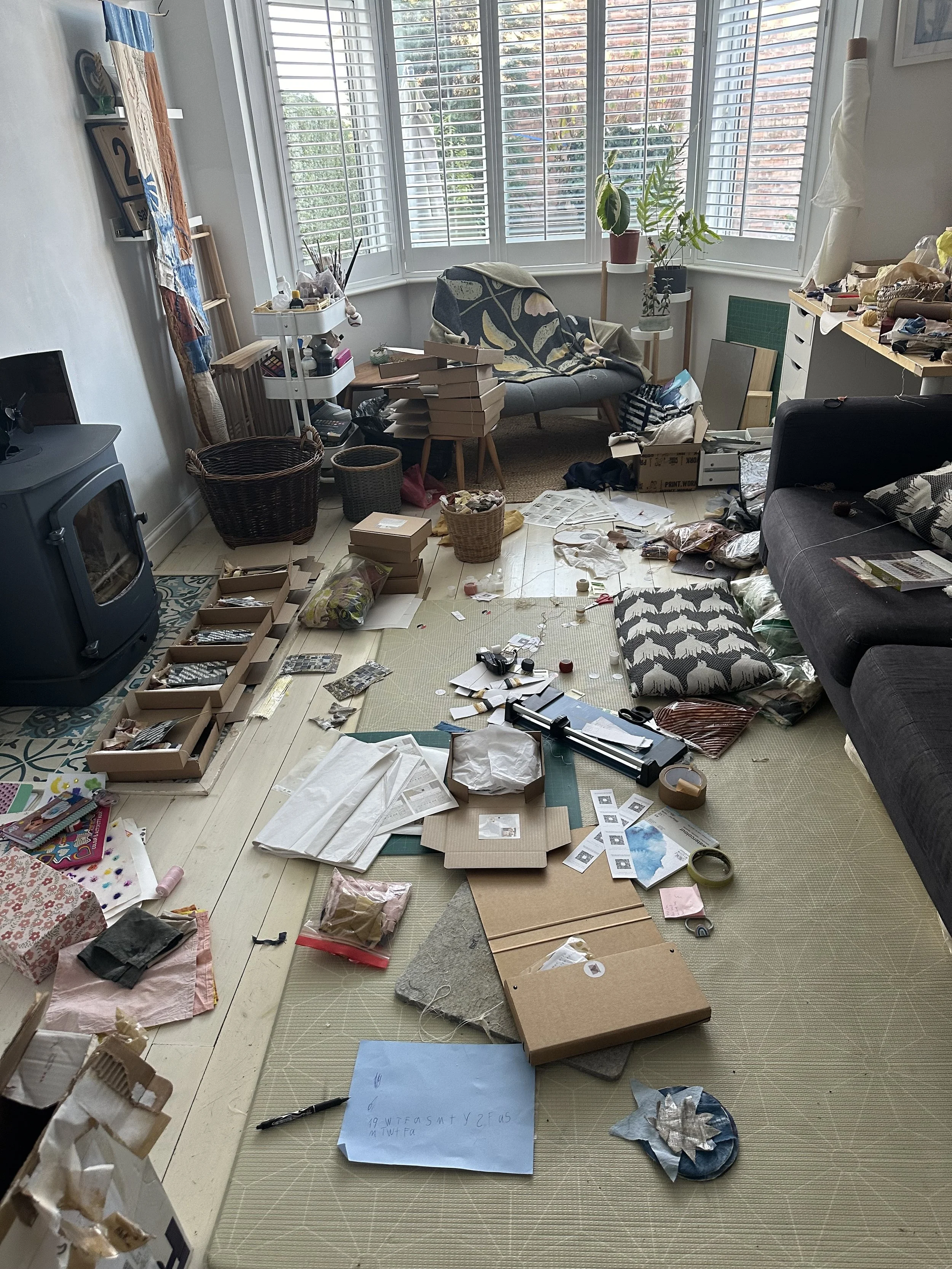Wayfinding: What I Learned After Quitting My Job to Become an Artist
As a textile artist, the last few years have been an exploration of finding my place within the art and craft world. Making the leap from a secondary school art teacher to a full-time artist has been both an exhilarating and uncertain journey. In many ways, it’s been about wayfinding—learning how to navigate this new chapter, balancing insecurities about where I fit, and discovering ways to make this practice work for me at this stage of life.
This article is as much about reflecting on my journey over the past three years as it is about planning for the next. It serves as an opportunity for me to write down the lessons I've learned, the milestones I’ve hit, and the challenges I’ve faced. As I look ahead to the next year (and beyond), I’m working to clarify my goals and refine my vision. It’s a process of personal growth, as well as professional evolution.
While this article is deeply personal, I hope it also serves as inspiration for anyone thinking of following a similar path. Whether you’re contemplating a career shift, building your art practice, or navigating the complexities of social media, I want this to be a resource for those who are figuring out their own way. It’s a reminder that the journey is often uncertain, but by reflecting, planning, and remaining true to our craft, we can find our way forward.
Starting Out & Sharing My Work
One of the tools that has become integral to my journey is Instagram. While social media can often feel fleeting and fickle, for me, it has been an essential part of my practice. Sharing my work on Instagram has not only helped hold me accountable but has also been a way to document my progress, my struggles, and the connections I’ve made along the way.
Instagram became a space for me to share my journey and creative process, but it also introduced an invaluable sense of community. What started as a personal project grew into a global platform, allowing me to connect with like-minded artists and individuals who shared in the experience of stitching, mending, and creating. The feedback and encouragement I received from my growing following have been crucial in helping me recognise aspects of my work that I hadn't fully understood myself. It’s easy to doubt the worth of your own work when you’re deep in the process, but the support from my Instagram community has helped me see my work through fresh eyes.
Opportunities That Came from Sharing
As my Instagram following grew, it opened doors to opportunities I could never have anticipated. The act of sharing my process, my successes, and even my struggles brought attention to my work and led to invitations to collaborate and teach.
Some of the key milestones in my artistic journey include:
• Collaboration with Hayward Gallery for the Louise Bourgeois exhibition: This unexpected opportunity marked a pivotal moment in my career. I was invited to create quilts to accompany the Louise Bourgeois exhibition—one of my biggest inspirations. This collaboration highlighted how social media can bridge the gap between independent artists and major cultural institutions, creating new avenues for exposure.
• Teaching online courses: My teaching journey began when Selvedge Magazine invited me to deliver a workshop as part of its Wardrobe Revolution weekend. This led to a two-part workshop series. I've also been a part of Making Zen run by the lovely Kate Ward of Zen Stitching for two consecutive years. These experiences have been invaluable in shaping my approach to digital teaching, ultimately inspiring me to create my own online courses.
• Offering workshops in techniques like reverse applique and slow stitching: By offering hands-on learning experiences, I’ve had the chance to connect with individuals who want to grow alongside me. These workshops have allowed me to share my skills and build a community of like-minded creators.
• Kits Collaboration with Helen Round: After Helen reached out to me for a collaboration, we worked together on creating Slow Stitch Coaster Kits and Slow Stitch Mini Quilt Kits. I had been considering creating a kit for a while but lacked the space and experience to put one together. With Helen’s established textile business and our shared commitment to sustainability, the partnership made perfect sense. I filmed and created the content, while Helen oversaw the manufacturing of the kits, bringing them to life with her expertise.
• The Kindness Quilt: This collaborative project, which involved 28 primary schools across Nottingham, was designed to engage children in a shared creative experience. Drawing on my teaching background, I created a project for teachers to work on with their students for Rse Day. Schools across the UK created a paper Kindness Quilt, while selected Nottingham schools made quilt blocks from fabric packs I sent out. Once I received the blocks back, I sewed them together, adding a stitched border featuring the names of all participating schools. The quilt has toured various venues across Nottinghamshire, helping spread the message of kindness and community.
• The Fabric of Home exhibition: This exhibition, which paired my work with research into housing insecurity, was both a personal milestone and a powerful platform to spark important conversations on housing insecurity. It provided an opportunity to showcase my art while addressing a topic close to my heart, reaching a wider audience in the process.
These opportunities were only possible because I had shared my work online, where it could be seen by the right people at the right time.
My first big opportunity , collaborating with the Hayward Gallery shop to create quilts during Louise Bourgeois: The Woven Child exhibition.
Balancing Visibility with Doubt
However, with all the good comes the complexity of what it means to build visibility on a platform like Instagram plus my growing concern about the ethical values of Meta has made me question how much I want to align myself with a company whose practices I don’t always agree with. While having a large following can feel validating, it also brings up feelings of doubt. Sometimes, I wonder if the opportunities I’m receiving are based on the numbers—on the followers—rather than the quality of my work. I worry that the real art world might view my success as superficial, that Instagram could be seen as a frivolous platform for “frivolous” art.
For example, in 2022, I applied for DYCP funding to explore plant dyes and expand into larger-scale work. I received support through a mentoring scheme run by New Art Exchange, where I received lots of positive feedback, which made me feel more confident in my application. However, I didn’t receive the funding. Although I knew how competitive it was, and that rejection was part of the process, it still felt like a real setback. I haven’t applied for funding since then, but I will again. The experience left me questioning the value of my work and whether opportunities like this are even accessible for me.
The truth is, while Instagram has played a role in creating visibility, I remind myself that the work itself is what resonates with others. People follow me because they connect with my approach, my materials, and the themes in my art. I’ve found that the community aspect—the shared conversation, the ongoing feedback—is what truly fuels my practice. Yet, the fear of losing this platform, or seeing it disappear overnight due to something like a hack, is ever-present. I would lose a part of my artistic record, and that feels unsettling.
Learning to Say No: The Power of Boundaries
In the early stages of my career, I found myself saying yes to nearly every opportunity that came my way. If someone wanted to commission me, I was flattered and excited to accept, even if the project didn’t align with my style or vision. This led to mental strain as I worked on projects that didn’t spark joy or passion. I poured so much energy into these commissions that I neglected the aspects of my practice I truly wanted to develop.
There were times I undercharged for my work, which left me feeling resentful and drained. The work took longer than expected, and my anxiety about completing it, combined with feelings of guilt and self-doubt, made the process even harder. Eventually, I stopped offering commissions completely due to the stress they caused.
Now, I’ve learned to say no to projects that don’t align with my values or creative vision. Saying no is as valuable as saying yes, and I’m more mindful of the work I take on. I now only accept commissions that I feel passionate about and that fairly compensate me for my time and effort.
A sneak peek of a current commission that I am excited to be working on.
Building a More Sustainable Foundation
To mitigate the risks of relying solely on social media, I’ve made intentional steps to build a more sustainable foundation for my practice. I’ve updated my website to better reflect where I am now in my artistic journey and to showcase my work in a way that feels more cohesive and true to my evolving practice. Additionally, I’ve focused on growing my mailing list, which now reaches 3,500 subscribers. This list has become a way for me to connect directly with people who are genuinely interested in my work, outside of social media algorithms.
I’ve also been reaching out to local spaces in Nottingham about offering workshops. I want to build a stronger presence in my local community and engage directly with people who may not be as active online. My hope is that these face-to-face interactions will deepen the relationships I’ve formed and broaden my network.
The Taboo of Making Money: Shifting My Mindset Towards Sustainability
Making money from your art can often feel like a taboo subject. There’s an unspoken expectation that artists should work for very little, or even for free, simply for the “exposure” or as a gesture of passion. This mindset can make it uncomfortable to talk about turning creativity into a livelihood, as if charging for art somehow devalues it. Yet, the truth is that running a creative business involves numerous hidden costs—materials, studio space, marketing, time spent on administration—and these expenses can't be ignored. Artists are often expected to offer their work at a fraction of its worth, undervaluing the immense effort and skill that goes into each piece.
Last year, I had a mindset shift. If I wanted the freedom to make my art, I needed to get serious about seeing my practice as a business. This meant exploring ways to diversify my income and create sustainable revenue streams. I had to face the fact that the financial side of things is just as important as the artistic side. It wasn't enough to rely solely on commissions and sales; I needed to build something that could keep running in the background, creating steady income that would give me the financial freedom to focus on the work I truly loved, even if it wasn't always the highest-paying.
So, I paused commissions and shifted my focus to creating digital resources. This was a leap for me. I had always wanted to create something that could generate income after the initial setup. It was a challenge to step out of my comfort zone, but I'm happy to say that it’s been a good decision. In fact, there were times when I came close to packing it all in, feeling overwhelmed by the unpredictability of it all. But now, while my income is still unpredictable at times, it’s far more stable than it was. It’s given me the breathing room to focus on creating the art I’m passionate about, without the constant worry about how to pay the bills.
This shift has enabled me to take the next big step: finding a studio space of my own.
My New Studio Space
For the past three years, I’ve been working in my living room, which, while cozy, was far from ideal. My house is very open-plan. We eat, live, and play in the same space. My desk was constantly overflowing with piles of fabric scraps, threads were scattered throughout the house, and I was always on edge about my daughter’s sticky fingers potentially getting on my art. There was no division between my work life and home life, it was a strain on my relationship and I felt like I could never escape the mess.
The Messy reality of a home studio - something had to change!
After only one month in my new studio space, I can already see how much of a positive impact it’s had. I now have the space I need to create, and the best part is—it’s my space. I can leave it as messy as I like without worrying about the living room becoming a chaotic mess. The physical separation between work and home life has been incredibly beneficial for my productivity. I no longer feel like my art is something I have to squeeze into the corners of my life. It’s become a distinct part of my routine.
Psychologically, it’s made a huge difference. Having my own space has made me feel like more of a professional. There’s no longer a question of whether this “thing” I’ve been building for the last three years is just a hobby or a pipe dream. I get up every morning excited to go to work—into my own space, with the freedom to create and focus on the things that matter most to me. To add to this, I’ve joined a gym in the same building. It’s made a huge difference to both my physical and mental wellbeing, giving me a sense of balance and routine that supports both my creative work and personal health.
Beginning to organise my new studio space
Next Steps & Opportunities
Looking Ahead: Expanding Locally and Nationally
I’m focused on expanding both locally and nationally, seeking opportunities that align with my work and allow me to showcase it in diverse contexts. This includes residencies, exhibitions, craft fairs, and gallery opportunities, as well as high-end craft events. Some of the opportunities I’m looking to explore include:
• Residencies and Exhibitions: I’m seeking residency opportunities that will allow me to focus on new projects while connecting with other artists.
• Selected Craft Fairs: I’m targeting craft fairs that align with my values and the kind of handmade textile art I create, such as Lustre Nottingham and the Hepworth Christmas Art Fair. These fairs offer a platform to showcase my work to an audience that understands and appreciates the craftsmanship behind textile art.
• Open Call Galleries: I’m actively seeking open call galleries to present my work to a broader audience. One gallery I’m particularly interested in is The Old Lock Up Gallery in Derbyshire, which could provide a fresh context for my art.
• High-End Craft Opportunities: Long-term, I’m aiming for prestigious events like Collect or Crafts Week’s Future Icons, which represent exciting opportunities for recognition within the high-end craft world.
• Festival of Quilts: I’m also planning to enter my quilts into the prestigious Festival of Quilts, a fantastic opportunity to showcase my work among fellow textile artists and reach an international audience.
Embracing Both Social Media & Real-World Connections
At the heart of this journey is the constant balancing act between digital visibility and real-world connection. While social media has been instrumental in offering opportunities and expanding my practice, I am mindful of how I build and secure my artistic foundation outside of it. My work has always been about finding my way—and sharing that journey has not only helped me grow but has also connected me with a community of like-minded individuals and institutions that continue to challenge and inspire me.
I’m excited to see where the next chapter of this journey takes me—whether online or in the tangible spaces where art lives and breathes.






